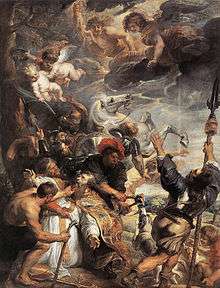Livinus
Saint Livinus (c. 580 – 12 November 657), also Livinus of Ghent, was an apostle in Flanders and Brabant, venerated as a saint and martyr in Catholic tradition and more especially at the Saint Bavo Chapel, Ghent.[1] His feast day is 12 November.
Saint Livinius | |
|---|---|
 The Martyrdom of St Livinus - Rubens, 1633 | |
| Born | c.580 Ireland |
| Died | 12 November 657 Sint-Lievens-Esse, Flanders |
| Venerated in | Roman Catholic Church |
| Feast | 12 November |

Legend and hagiography
Details of the biography of Deventer saint Lebuinus were used to compile the Passio of St Livinus.[1]
The legend goes that Livinus was born from Irish nobility. Upon studies in England, where he visited Saint Augustine of Canterbury, he returned to Ireland. He later went on a peregrinatio Domini and left Ireland for Ghent (Belgium) and Zeeland (Netherlands) where he preached. During one of his sermons, Livinus was attacked in the village of Esse, near Geraardsbergen by a group of pagans who cut off his tongue and head.[2]
The villages of Sint-Lievens-Esse, where he was murdered, and Sint-Lievens-Houtem, where he was buried, were named after him.
His remains were transferred to Ghent around the turn of the millennium, but went missing and are believed to have been destroyed in 1578 during the Second Iconoclasm.
Myth or reality?
Recent research questions the existence of Saint Livinus.[1][3][4] There are resemblances between Saint Livinus and Saint Lebuinus of Deventer (Netherlands), an English missionary who died in Deventer c. 775 and who is commemorated on 12 November in the Utrecht diocese. Both figures were engaged in the christening of pagans in the Low Countries and were confronted with similar conflicts and clashes. It has been argued that monks of the Saint Bavo Abbey in Ghent, Livinus' presumed place of residence, have launched the cultus of Saint Livinus and found inspiration in the life of Saint Lebuinus.
A hagiography of the saint (edited in Migne, Patrologia Latina, 89) was formerly ascribed to Saint Boniface.[5]
References
- Carasso-Kok, M. (1981). Repertorium van verhalende historische bronnen uit de middeleeuwen heiligenlevens, annalen, kronieken en andere in Nederland geschreven verhalende bronnen. Brill Archive. p. 54 ff. ISBN 90-247-9132-4.
- Monks of Ramsgate. “Livinus”. Book of Saints, 1921. CatholicSaints.Info. 8 November 2014

- Decavele, J.; H. Balthazar; P. Ruyffelaere (1989). Gent, apologie van een rebelse stad. Antwerpen: Mercatorfonds. p. 55. ISBN 90-6153-201-9.
- Brabant, J. van (1972), Sint-Lieven of Sint-Bavo. Aantekeningen bij een groot schilderij
- Kuhlmann, Bernhard (1895). Der heilige Bonifatius, Apostel der Deutschen. Verlag der Bonifacius-Dr. p. 497.
Further reading
- Coens, M. (1952). "L'auteur de la Passio Livini s'est-il inspiré de la Vita Lebuini?". Analecta Bollandiana. 70: 285–305.
- Coens, M. (1963). "Litanies Gantoises". Recueil d’études bolandiennes. Subsïdia Hagiographica 37. Brussels. pp. 258–70.
- Holder-Egger, O. (1886). "Zu den Heiligengeschichten des Genter St. Bavosklosters". Historische Aufsätze dem Andenken an Georg Waitz gewidmet (in German). Hanover. pp. 644–59.
- On the Livinus Gospels:
- McGurk, Patrick (1963), "The Ghent Livinus Gospels and the Scriptorium of Saint-Amand", Sacris Erudiri, 14: 164–205 Reprinted in McGurk (1998), Gospel Books and Early Latin Manuscripts. Ashgate.
- Nees, Lawrence (2001). "On Carolingian Book Painters: The Ottoboni Gospels and Its Transfiguration Master". The Art Bulletin. 83: 209–39.
- Nees, Lawrence (2002). "Evangeliarium van Livinus". In Patrick de Rynck (ed.). Meesterlijke middeleeuwen: Miniaturen van Karel de Grote tot Karel de Stoute, 800–1475 (in Dutch). Zwolle and Louvain. pp. 104–5.